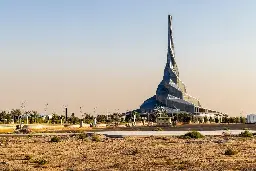Even if you could magically increase the number of nuclear reactors started before 2012 tenfold to keep up with wind and solar, you'd have to triple uranium mining overnight to fuel them for the first time.
Fuck off shill. All of your lies have been dealt with already.
Now is the part where you shit on the board and declare victory.
Reactionary shills are always so fragile.
I'm quite capable of communicating without namecalling. But when I see a shill shilling, I point out the shilling.
Wow. What an insightful comment.
Fuck off shill.
I didn't want to get into an argument with an imbecile about eggs. But here we are.
https://www.iowafarmbureau.com/Article/Relative-Value-of-Soybean-Meal-and-Soybean-Oil
Most of the revenue is the meal. Nobody would grow it for the oil.
Almost half of the oil is used for biodeisel. So even if it were exclusively for the oil (a lie) getting rid of 40% and getting rid of the meat would do more than green fertizer
Also all an attempt at distraction because humans could eat a plant grown there.
The oil is the byproduct, idiot.
While some of the crop is used directly, more than 85 percent is further processed through crushing into soybean meal and oil. Soybean meal is typically used as an animal feed for its protein content
The meal is the main revenue source and the reason it's grown.
So almost all of it going to animal feed is somehow all of it being for human consumption?
Fuck off and stop trying to gaslight, shill.
I said red meat. Pork and chicken need to go too, but that'snot as urgent.
Paltering.
Corn and soy grown for the purpose of large animal feed exceeds the amount of cropland used directly for human consumption in areas where <20% of calories and protein come from red meat.
Another solution would be adding some intelligence to water heaters. Have a temperature control valve on the output where you set the temperature, and program the water heater get to 160-180°F when electricity is cheap. This would be a thermal battery that would easily level out demand for electricity for heating water.
This has been done for close to a century in wind or run of river hydro heavy countries (as well as some coal ones).
The water heater has a buffer tank and is attached to a meter that only runs when a signal is sent across the power line. This stores about 20kWh for a 300L tank.
Modern insulation would allow going up to a few m^3 for a couple weeks' worth.
Yes. It costs less and requires less mining to use the most expensive and wasteful storage option. The only reason there aren't more is a lack of sufficient investment in VRE required to make them useful.
Adding 1GW that runs 80% of the time with months long outages to a grid that has 10GW of power available 95% of the time and 3GW 5% of the time doesn't fix the issue and requires charging $4000/MWh rather than merely $200/MWh to pay back your boondoggle.
All the people chanting "baseload" understand this but pretend not to.
Coal is filthy, but this is a myth and also an attempt at paltering.
Someone compared a poorly filtered coal plant running cherry picked coal to a brand new nuclear plant in the middle of its fuel cycle once decades ago and got the expected result.
When you open it and get the fuel out and when you mine the fuel it's orders of magnitude more. Reprocessing plants like La Hague under normal operation release more of the long lived radiation than fukushima and TMI combined.
The U235 is good for about 3 years, and pinning everything on something that has never had more than a half proof of concept is a bad choice.
Why is it supposed to be easier to get people onboard with nuclear (which is decreasing) than wind and solar (which are increasing at triple the rate of the nuclear construction peak in the 80s and growing at 20% p.a.)?
People are on board with VRE. Some of the are on board with nuclear too, but it's not working.
Four points:
The profile of other is short spikes 5-100 hours a few times a year.
1 year of delay is equivalent to 20 years of exclusively using fossil fuels for "other".
It's not even obvious that adding nuclear reactors would reduce this because they're so geographically and temporally inflexible. France has 63GW of nuclear capacity, <45GW of average load and 61GW of winter peak load with vast amounts of storage available via interconnect to hydro countries. They still use 5% gas on top of the rest of the "other" (which is about 10-25GW).
5% of other from gas adds about 20g CO2e/kg per kWh to the total. Less than the margin between different uranium sources.
Running 40% of the capacity 10% of the time puts your nuclear energy in the realm of $1-3/kWh. The list of ways of generating or storing 6% of your energy for <$1/kWh is basically endless.
That's about 4-8TW of capacity worldwide. 1kg of uranium is good for fuelling about 750W of reactor on a 6 year fuel cycle. Loading those reactors would require digging up all of the known and assumed-to-exist uranium immediately.
Nuclear is an irrelevant distraction being pushed by those who know it will not work. You only have to glance at the policy history or donor base of the politicians pushing for it in Sweden, Canada, Australia, UK, Poland, etc etc or the media channels pushing it to see how obvious it is that it's fossil fuel propaganda.
It is obviously obviously true that it's a non-solution. It fails on every single metric. All of the talking points about alleged advantages are the opposite of the truth without exception.
When you demand free insurance from someone they get to set the risk profile.
Tell you what. You put up collateral equal to the value of any nearby city and everything in it, and you can stop ALARA.
Also even with that it's still bullshit. Nuclear had a higher negative learning rate before ALARA and is still horrifically expensive outside the US.
Also the suggestion that wind and solar aren't subject to more extreme regulation on potential harms is even more ridiculous.
Like the free insurance, or the free loans, or the underfunded decomissioning and waste management, or the unremediated mines?
Or is it the storage and grid redundancy required to meet peak load with a generator that runs at constant output and shuts down for months at a time?
Masdar's bid of 1.6215 USD cents/kWh sets record for lowest Levelised Cost of Energy (LCOE) among DEWA's solar projects. Phase 6 to be operational from Q4 2024, contributing to Dubai's clean energy goal

Uranium is $128.30/kg
After enrichment, conversion and fabrication that's $3400/kg for 4.95% fuel.
At 36-45MWd/kg and a net thermal efficiency of 25% or $12.5/MWh up front.
With a 90 month lead time (72 month fuel cycle and 18 months inventory) at 3% this is $16.2/MWh
American researchers are proposing to use steel zip ties to attach solar modules to fences in animal farms as a low-cost racking solution for agrivoltaic applications. They found the proposed approach is technically and economically viable, provided careful wind load tests are conducted on the fence...
